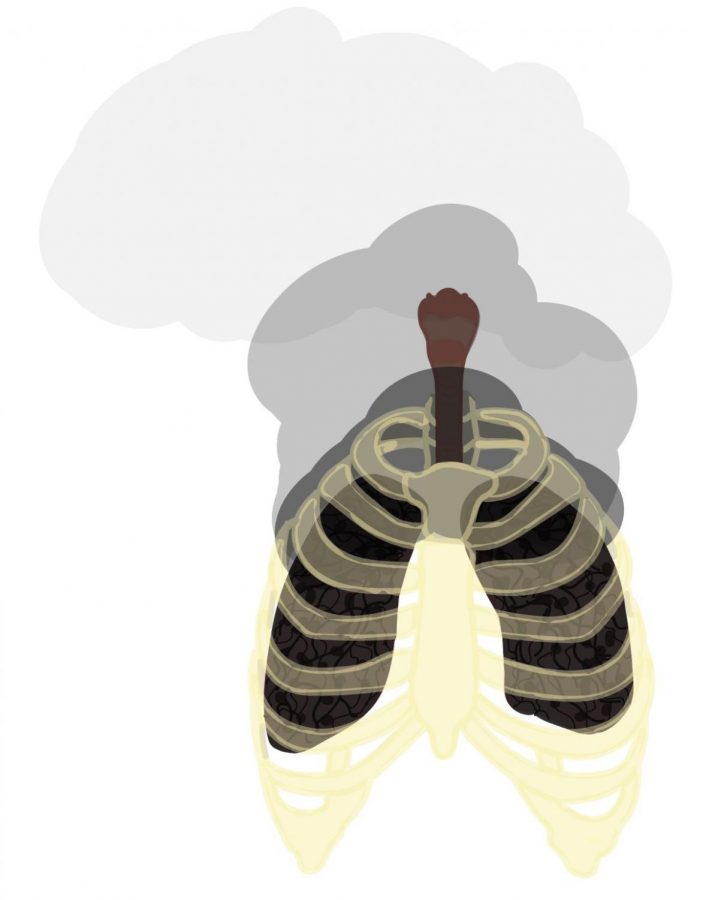Vape users face unknown dangers
Cases of vaping-related injuries have skyrocketed recently. What does this mean for high schoolers that e-cigarettes are popular with?
October 17, 2019
As of Oct. 1, the Centers for Disease Control and Prevention has confirmed 1,080 cases of vaping-related lung injury in the U.S. and 18 deaths, with the numbers rising every day. Patients reported symptoms of coughing, nausea, shortness of breath and more. Symptoms reportedly developed anywhere from within a few days to over the course of several weeks.
While the majority of these vaping-related disease cases were in patients age 18-34, 16% were under the age of 18, according to the CDC. The CDC has yet to determine the cause of the lung injuries but suspects it to be due to chemical exposure, not an infection. Some have blamed the THC cartridges that most patients have reported using.
THC, or tetrahydrocannabinol, the psychoactive ingredient in marijuana, is not legal to sell in e-cigarette cartridges. According to Alexander Sharpe, store manager of Vapor World in Overland Park, this means that smokers won’t know what they’re inhaling, unlike with regulated e-cigarette manufacturers.
“A lot of these [cases] are specifically trailing back to black market THC cartridges which don’t necessarily have to do with vaping,” Sharpe said. “Because they’re putting it on a vape pen, they’re lumping it in with vaping in general and saying that’s what’s getting people sick or creating lung disease, things along those lines, whereas with our company and all other companies, as far as people who have the correct licenses and the ability to sell in places like this, they all have juices that specifically talk about what they contain.”
Vaping is defined as “the act of inhaling and exhaling the aerosol, often referred to as vapor, which is produced by an e-cigarette or similar device” by the Center on Addiction. Since the mass introduction of e-cigarettes to the U.S. in 2007, its popularity increased among young people. Vaping devices, commonly called vape pens, consist of a cartridge which holds e-juice, a heating device that turns that e-juice into an aerosol, a battery for the heating device and a mouthpiece.
According to the National Institute on Drug Abuse, 20.9% of high school seniors in 2018 reported vaping nicotine in the last month, nearly twice the amount from the year before.
Michelle Irwin is a community outreach specialist at FirstCall, an addiction center founded in 1958 that connects people with addiction to resources such as counseling agencies and tries to prevent youth substance usage.
“It is the number one drug of choice by the high schoolers in Jackson County,” Irwin said. “It bypassed alcohol, marijuana and prescription drugs.”
According to Irwin, e-cigarette companies have a history of being problematic when it comes to their young consumers.
“They’ve been targeted and fined and made to remove their products off the shelves because it’s targeted towards youth,” said Irwin. “I mean, who else would want to smoke a vape…that tastes like chocolate chip cookies? Or cherry bombs?”
She compared the recent outbreak of lung injuries to “popcorn lung,” a disease formally known as bronchiolitis obliterans. Workers who got the disease were overly exposed to inhaling vapor from an artificial butter flavoring called diacetyl. This caused their bronchial tubes to swell shut, rendering them unable to breathe. Eight cases of the disease in former microwave popcorn factory workers were reported in 2000, according to the CDC.
“If you drink Kool-Aid or if you have had chewy candies or gum or anything like that you’re getting essentially the exact same products you would in any of these, sans nicotine,” Sharpe said.
However, Irwin doesn’t believe it’s safe to inhale what you can digest, like in the case of the factory workers.
“It’s safe to eat but not safe to breathe,” said Irwin. “…It’s not the job of the Food and Drug Administration to tell us what we can breathe and what we can’t, it’s what we can eat safely.”
Vaping supply stores like Vapor World are currently regulated by the FDA and companies are required to list their ingredients. According to Sharpe, e-juices contain nicotine, vegetable glycerin, propylene glycol, a food-grade additive and flavorants.
However, users of e-cigarettes face other potential dangers. According to the CDC, e-cigarette aerosols can contain diacetyl, the chemical that causes popcorn lung, as well as ultrafine particles and heavy metals. Additionally, consuming nicotine can lead to addiction. Nicotine is the fourth most addictive drug, according to American Addiction Centers.
“I think the majority of [young e-cigarette users] go on to smoke cigarettes because they become addicted to nicotine,” said Irwin. “It has been shown that yes, it is a gateway drug, and to other drugs as well.”
According to the CDC, increase in e-cigarette use is causing a rise in tobacco product usage. Brian King, the Deputy Director of the CDC’s Office of Smoking on Health, believes that the cause is clear.
“The advertising will bring a horse to water, the flavors will get them to drink, and the nicotine will keep them coming back for more,” King said.
One e-cigarette company in particular, Juul, carries the majority of all U.S. e-cigarette retail market sales, according to Vox. Juul is different than traditional e-cigarettes, both in its sleeker appearance and how it works. It delivers more nicotine than other e-cigarettes, with about the same amount of nicotine that is in a tobacco cigarette. This is three times the nicotine levels allowed in the European Union. The company witnessed a slowdown in demand for products amid the news about illness outbreak, according to CNBC.
Currently, the CDC recommends that people “consider refraining from using e-cigarette, or vaping, products, particularly those containing THC,” until more is known.








